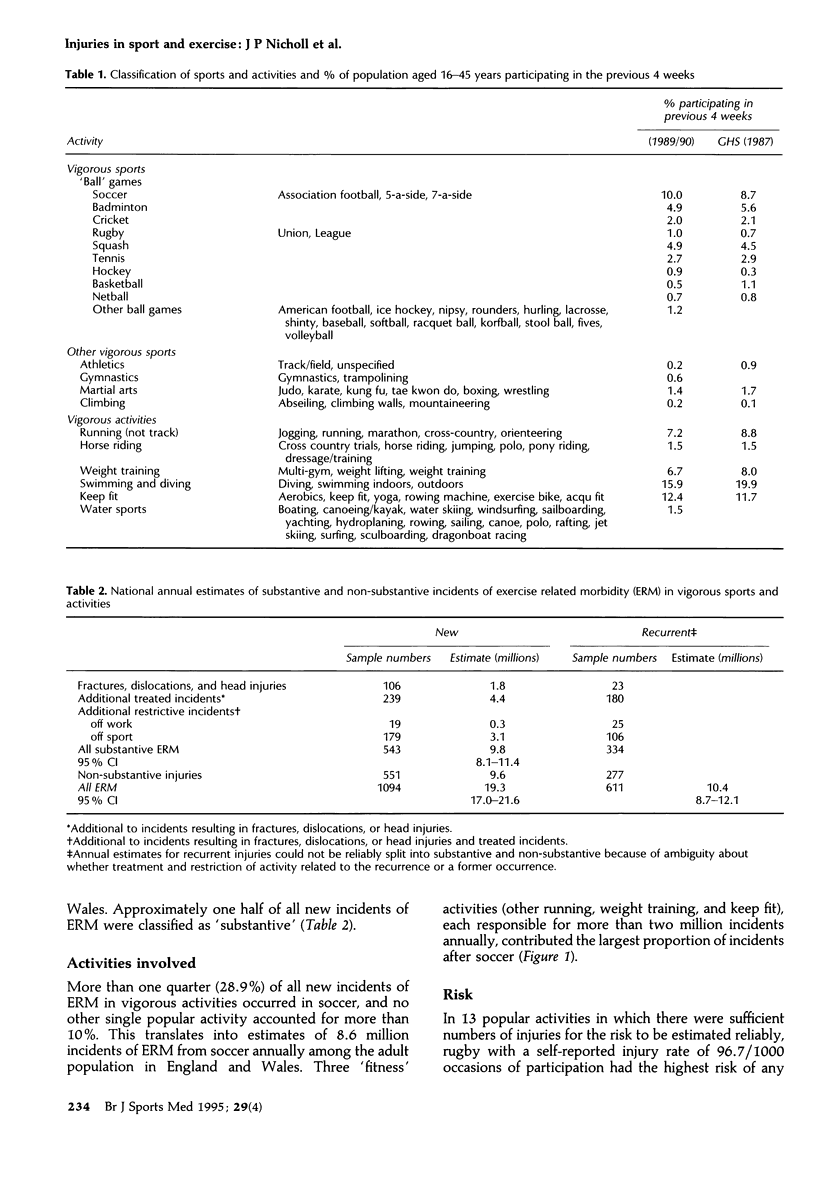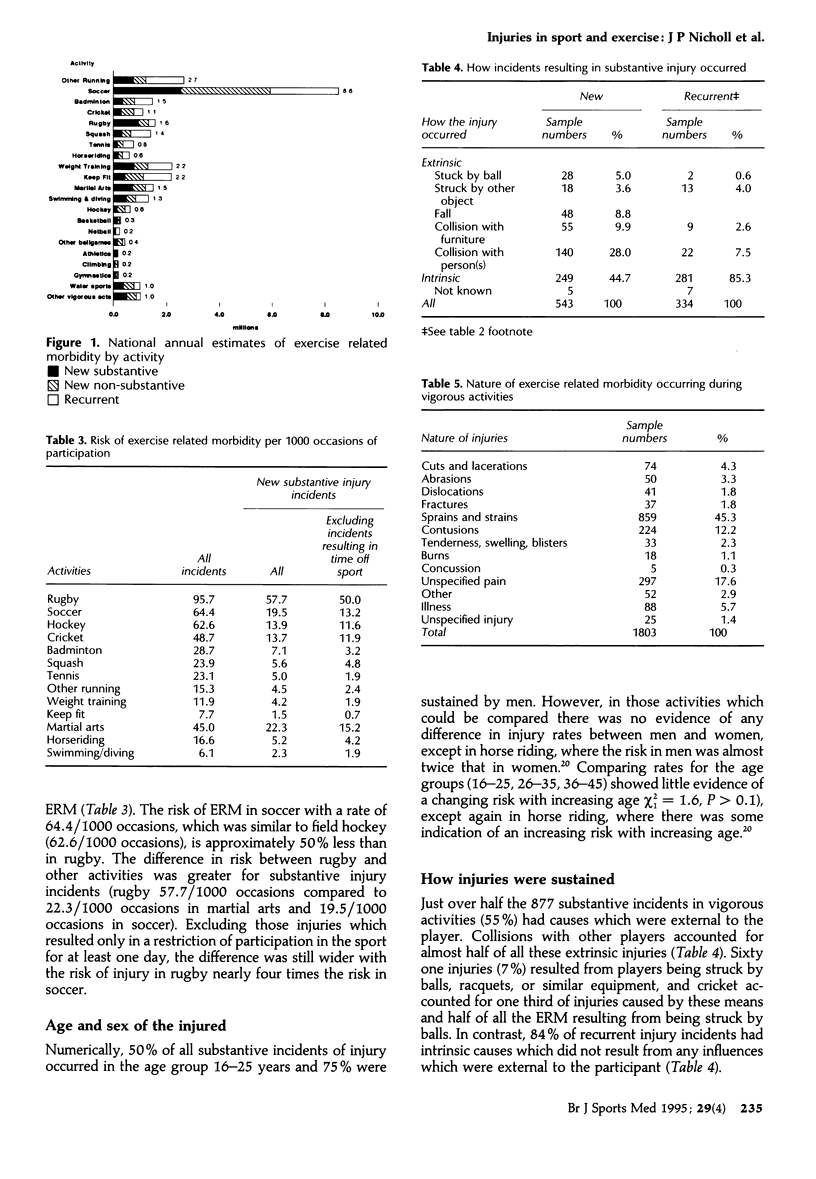Abstract
A national study of exercise related morbidity (ERM) in England and Wales was carried out using a postal questionnaire sent to 28,857 adults aged 16-45 years. The questionnaire asked about regular participation in sports or other recreational fitness activities involving physical exercise, and for details of any injuries occurring during a 28 d reference period. A return rate of 68% was achieved. Comparisons with other national data sources indicated that the information obtained was reliable. It is estimated that each year there are 29 million incidents resulting in new or recurrent injuries, however minor, of which 9.8 million (95% confidence interval 8.1 to 11.4 million) result in new 'substantive' injuries which are potentially serious, result in treatment, or in participants being unable to take part in their usual activities. Soccer accounted for more than 25% of all ERM, but the risk of a substantive injury in rugby was three times that in soccer. Over one third of ERM occurred in men aged 16-25 years. The most frequently reported injuries were sprains and strains of the lower limbs. Treatment was sought in approximately 25% of ERM incidents and 7% of all new ERM incidents involved attendance at a hospital accident and emergency department. The treatment provider most likely to be consulted was a general practitioner, but physiotherapists and complementary medicine practitioners were also consulted frequently. To maximize the health benefits of exercise, research strategies to reduce the volume and severity of ERM and to identify the most appropriate ways of managing ERM should be set.
Full text
PDF






Selected References
These references are in PubMed. This may not be the complete list of references from this article.
- Beardow R., Oerton J., Victor C. Evaluation of the cervical cytology screening programme in an inner city health district. BMJ. 1989 Jul 8;299(6691):98–100. doi: 10.1136/bmj.299.6691.98. [DOI] [PMC free article] [PubMed] [Google Scholar]
- Bedford P. J., Macauley D. C. Attendances at a casualty department for sport related injuries. Br J Sports Med. 1984 Jun;18(2):116–121. doi: 10.1136/bjsm.18.2.116. [DOI] [PMC free article] [PubMed] [Google Scholar]
- Burry H. C., Calcinai C. J. The need to make rugby safer. Br Med J (Clin Res Ed) 1988 Jan 16;296(6616):149–150. doi: 10.1136/bmj.296.6616.149. [DOI] [PMC free article] [PubMed] [Google Scholar]
- Forward G. R. Indoor cricket injuries. Med J Aust. 1988 Jun 6;148(11):560–561. doi: 10.5694/j.1326-5377.1988.tb93811.x. [DOI] [PubMed] [Google Scholar]
- Fraser R. C., Clayton D. G. The accuracy of age-sex registers, practice medical records and family practitioner committee registers. J R Coll Gen Pract. 1981 Jul;31(228):410–419. [PMC free article] [PubMed] [Google Scholar]
- Jones N. P., Tullo A. B. Severe eye injuries in cricket. Br J Sports Med. 1986 Dec;20(4):178–179. doi: 10.1136/bjsm.20.4.178. [DOI] [PMC free article] [PubMed] [Google Scholar]
- Kallinen M., Alén M. Sports-related injuries in elderly men still active in sports. Br J Sports Med. 1994 Mar;28(1):52–55. doi: 10.1136/bjsm.28.1.52. [DOI] [PMC free article] [PubMed] [Google Scholar]
- Lindner K. J., Caine D. J. Injury patterns of female competitive club gymnasts. Can J Sport Sci. 1990 Dec;15(4):254–261. [PubMed] [Google Scholar]
- McEwen J., King E., Bickler G. Attendance and non-attendance for breast screening at the south east London breast screening service. BMJ. 1989 Jul 8;299(6691):104–106. doi: 10.1136/bmj.299.6691.104. [DOI] [PMC free article] [PubMed] [Google Scholar]
- Nicholl J. P., Coleman P., Brazier J. E. Health and healthcare costs and benefits of exercise. Pharmacoeconomics. 1994 Feb;5(2):109–122. doi: 10.2165/00019053-199405020-00005. [DOI] [PubMed] [Google Scholar]
- Nicholl J. P., Coleman P., Williams B. T. Pilot study of the epidemiology of sports injuries and exercise-related morbidity. Br J Sports Med. 1991 Mar;25(1):61–66. doi: 10.1136/bjsm.25.1.61. [DOI] [PMC free article] [PubMed] [Google Scholar]
- Nicholl J. P., Williams B. T. Medical problems before and after a popular marathon. Br Med J (Clin Res Ed) 1982 Nov 20;285(6353):1465–1466. doi: 10.1136/bmj.285.6353.1465. [DOI] [PMC free article] [PubMed] [Google Scholar]
- Silver J. R. Injuries of the spine sustained during rugby. Br J Sports Med. 1992 Dec;26(4):253–258. doi: 10.1136/bjsm.26.4.253. [DOI] [PMC free article] [PubMed] [Google Scholar]
- Silver J. R. Spinal injuries in sports in the UK. Br J Sports Med. 1993 Jun;27(2):115–120. doi: 10.1136/bjsm.27.2.115. [DOI] [PMC free article] [PubMed] [Google Scholar]
- Watters D. A., Brooks S., Elton R. A., Little K. Sports injuries in an accident and emergency department. Arch Emerg Med. 1984 Jun;1(2):105–111. doi: 10.1136/emj.1.2.105. [DOI] [PMC free article] [PubMed] [Google Scholar]


